
The Araceae are a family of monocotyledonous flowering plants in which flowers are borne on a type of inflorescence called a spadix. The spadix is usually accompanied by, and sometimes partially enclosed in, a spathe or leaf-like bract. Also known as the arum family, members are often colloquially known as aroids. This family of 140 genera and about 3750 known species is most diverse in the New World tropics, although also distributed in the Old World tropics and northern temperate regions.

Lanark County is a county located in the Canadian province of Ontario. Its county seat is Perth, which was first settled in 1816. Most European settlements of the county began in 1816, when Drummond, Beckwith and Bathurst townships were named and initially surveyed. The first farm north of the Rideau was cleared and settled somewhat earlier, in 1790. The county took its name from the town of Lanark in Scotland. Nearly all the townships were named after British public and military figures from the era of early settlement.

The Bartlett Arboretum and Gardens in Stamford, Connecticut, contains 93 acres of parkland, gardens, landscapes, and hiking trails that focus on the regional plants, ecology and character of Southwestern New England. The Arboretum is open and accessible to the public every day of the year and is located at 151 Brookdale Road.
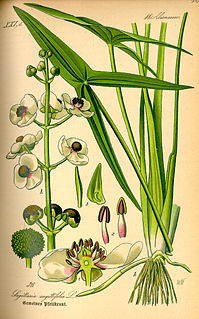
Sagittaria is a genus of about 30 species of aquatic plants whose members go by a variety of common names, including arrowhead, duck potato, katniss, Omodaka, swamp potato, tule potato, and wapato. Most are native to South, Central, and North America, but there are also some from Europe, Africa, and Asia.

Zantedeschia aethiopica, commonly known as calla lily and arum lily, is a species of flowering plant in the family Araceae, native to southern Africa in Lesotho, South Africa, and Eswatini.

Peltandra, the arrow arums, is a genus of plants in the family Araceae. It is native to the eastern United States, eastern Canada, and Cuba.
- Peltandra sagittifolia - (Michx.) Morong - Spoon flower or the white arrow arum - southeastern US from eastern Louisiana to Virginia
- Peltandra virginica(L.) Schott - Arum arrow - Cuba, Quebec, Ontario, Oregon, California, Washington; eastern US from Maine to Florida, west to Texas, Kansas, and Minnesota
- †Peltandra primaeva – Eocene, Golden Valley Formation, North Dakota, USA
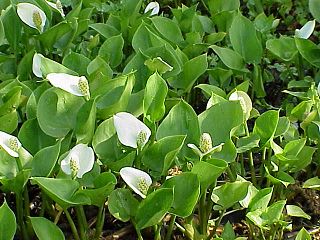
Calla is a genus of flowering plant in the family Araceae, containing the single species Calla palustris.
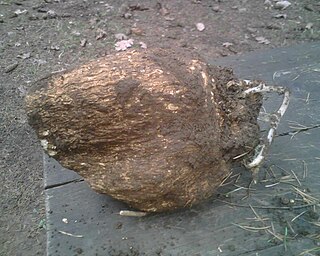
Wolfiporia extensa (Peck) Ginns is a fungus in the family Polyporaceae. It is a wood-decay fungus but has a subterranean growth habit. It is notable in the development of a large, long-lasting underground sclerotium that resembles a small coconut. This sclerotium called "(Chinese) Tuckahoe" or fu-ling(茯苓, pīnyīn: fúlíng), is not the same as the true tuckahoe used as Indian bread by Native Americans, which is the arrow arum, Peltandra virginica, a flowering tuberous plant in the arum family. W. extensa is also used extensively as a medicinal mushroom in Chinese medicine. Indications for use in the traditional Chinese medicine include promoting urination, to invigorate the spleen function, and to calm the mind.
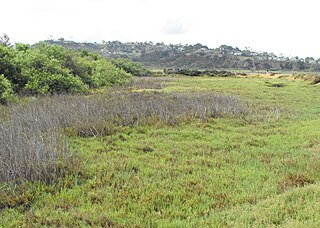
Brackish marshes develop from salt marshes where a significant freshwater influx dilutes the seawater to brackish levels of salinity. This commonly happens upstream from salt marshes by estuaries of coastal rivers or near the mouths of coastal rivers with heavy freshwater discharges in the conditions of low tidal ranges.
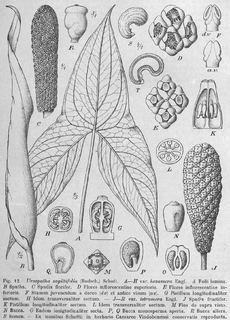
Urospatha is a genus of flowering plants in the family Araceae that consists of approximately 10 known species. They are found growing in South America and Central America in swamps, wet savannahs, and brackish water. The leaves of the species in this genus are upward pointing and sagittate (arrow-shaped). The inflorescences are quite unique; the spathe is mottled and elongated with a spiral twist at the end. The seeds are distributed by water and have a texture similar to cork that allows them to float. They also quickly germinate in water.

Typhonodorum is a monotypic genus of flowering plants in the family Araceae. The single species making up this genus is Typhonodorum lindleyanum. The genus is native to Madagascar, the Comores, Zanzibar, Réunion and Mauritius. This genus is believed to be closely related to Peltandra even though Peltandra is only found in North America and there don't appear to exist closely related genera in the African mainland. There isn't fossil evidence to link the two genera so it has been proposed that there once was a genus in Africa from which the two genera had originated. The African mainland genus spread to North America and to Madagascar 50 million years ago before it broke off. Then the African genus became extinct and the North American and Madagascan genera remained.
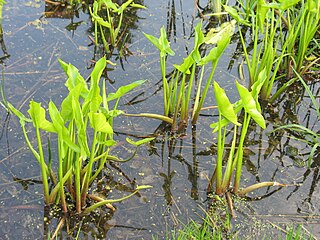
Peltandra virginica is a plant of the arum family known as green arrow arum and tuckahoe. It is widely distributed in wetlands in the eastern United States, as well as in Quebec, Ontario, and Cuba. It is common in central Florida including the Everglades and along the Gulf Coast. Its rhizomes are tolerant to low oxygen levels found in wetland soils. It can be found elsewhere in North America as an introduced species and often an invasive plant.

Spathicarpa hastifolia is a species of flowering plants in the family Araceae, endemic to South America.

Lysimachia asperulifolia is a rare species of flowering plant in the Primulaceae known by the common name rough-leaved loosestrife and roughleaf yellow loosestrife. It is endemic to the Atlantic coastal plain in North Carolina and northern South Carolina in the United States, where there are 64 known populations. It is a federally listed endangered species of the United States.

The Eastern Great Lakes and Hudson Lowlands region extends along the south shores of Lake Erie and Lake Ontario and the St. Lawrence River to Lake Champlain, and south down the Hudson River. It is primarily within the state of New York, with smaller portions in Vermont, Pennsylvania, and Ohio. In the north it meets the Mixedwood Plains Ecozone of Canada in eastern Ontario and southern Quebec. It is mostly temperate deciduous forest and agricultural land.
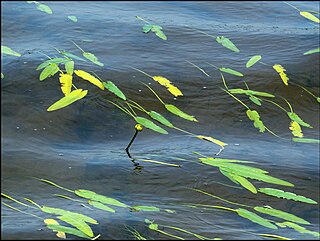
Nuphar sagittifolia, common name arrow-leaved water-lily or Cape Fear spatterdock, is a plant species known only from North Carolina, South Carolina, and Virginia. It is aquatic, found in lakes, ponds, and slow-moving rivers in the coastal plains of those states. It is also sold in pet shops as greenery to grow in aquaria and water-gardens.
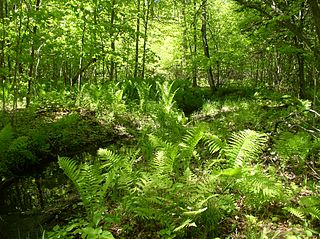
The Keddy Nature Sanctuary consists of approximately one square mile of forest and wetland on the very edge of the Canadian shield, just an hour west of Ottawa on the east side of Lanark County, in Ontario, Canada. It is mostly second growth temperate deciduous forest, interspersed with wetlands and beaver ponds, as well as sedge-dominated rock-ridges. A central ridge has more than twenty hectares of hemlock forest. There are also old fields that remain from pastures created in the previous century. Parts of this property, as well as adjoining lands, are designated as the Scotch Corners Provincially Significant Wetland. The property is one of several protected by the Mississippi Madawaska Land Trust.

Scotch Corners Wetland is a provincially significant wetland complex located in Lanark County, Ontario, Canada. The 202 hectares area has a wide array of wetland types including swamps, marshes, vernal pools, beaver ponds and seepage areas. It forms the headwaters of several creeks that drain into Mississippi Lake.
Typhonium peltandroides is a species of plant in the arum family that is endemic to Australia.
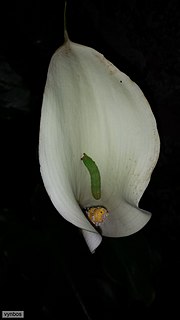
Zantedeschia odorata, the Bokkeveld arum, is a species in the arum family, Araceae. It is a tuberous, perennial plant that grows to a height of 75 to 100 cm. The flowers are yellow, have long narrow veins and are enclosed by a white leathery bract. The leaves are arrow-shaped. The plant grows in wetlands or along streams. The plant is rare and indigenous to the Northern Cape where it occurs on the Bokkeveld escarpment near Nieuwoudtville.

















